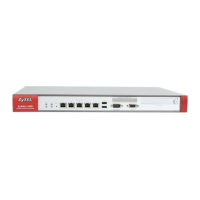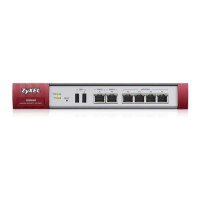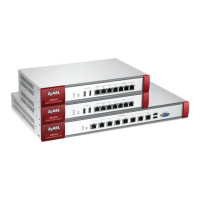Chapter 7 Route
ZyWALL (ZLD) CLI Reference Guide
70
The following table describes the commands available for policy route. You must use the
configure terminal command to enter the configuration mode before you can use these
commands.
Table 31 Command Summary: Policy Route
COMMAND DESCRIPTION
[no] bwm activate Globally enables bandwidth management. You
must globally activate bandwidth management to
have individual policy routes or application patrol
policies apply bandwidth management. The
no
command globally disables bandwidth
management.
policy
{<1..5000>|append<1..5000>|insert<1..5000>}
Enters the policy-route sub-command mode to
configure, add or insert a policy.
[no] bandwidth <1..1048576> priority
<1..1024> [maximize-bandwidth-usage]
Sets the maximum bandwidth and priority for the
policy. The
no command removes bandwidth
settings from the rule. You can also turn
maximize bandwidth usage on or off.
[no] deactivate Disables the specified policy. The
no command
enables the specified policy.
[no] description description Sets a descriptive name for the policy. The
no
command removes the name for the policy.
[no] destination {address_object|any} Sets the destination IP address the matched
packets must have. The no command resets the
destination IP address to the default (
any). any
means all IP addresses.
[no] interface interface_name Sets the interface on which the incoming packets
are received. The no command resets the
incoming interface to the default (
any). any
means all interfaces.
[no] next-hop {auto|gateway address object
|interface interface_name |trunk
trunk_name|tunnel tunnel_name}
Sets the next-hop to which the matched packets
are routed. The
no command resets next-hop
settings to the default (
auto).
[no] schedule schedule_object Sets the schedule. The no command removes
the schedule setting to the default (
none). none
means any time.
[no] service {service_name|any} Sets the IP protocol. The
no command resets
service settings to the default (
any). any means
all services.
[no] snat {outgoing-interface|pool
{address_object}}
Sets the source IP address of the matched
packets that use SNAT. The no command
removes source NAT settings from the rule.
[no] source {address_object|any} Sets the source IP address that the matched
packets must have. The no command resets the
source IP address to the default (
any). any
means all IP addresses.
[no] sslvpn tunnel_name Sets the incoming interface to an SSL VPN
tunnel. The
no command removes the SSL VPN
tunnel through which the incoming packets are
received.
[no] trigger <1..8> incoming service_name
trigger service_name
Sets a port triggering rule. The
no command
removes port trigger settings from the rule.
trigger append incoming service_name trigger
service_name
Adds a new port triggering rule to the end of the
list.

